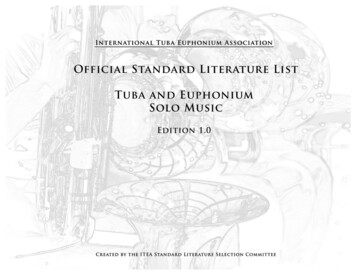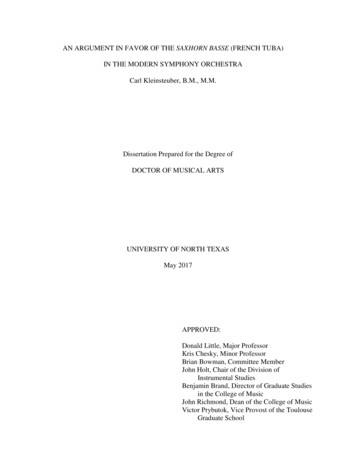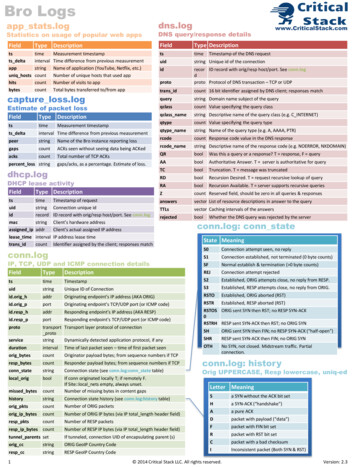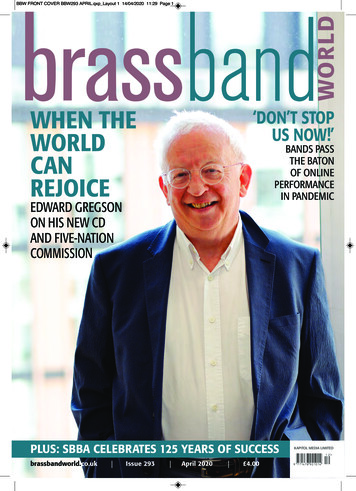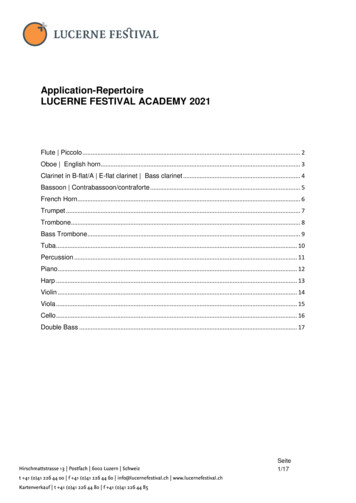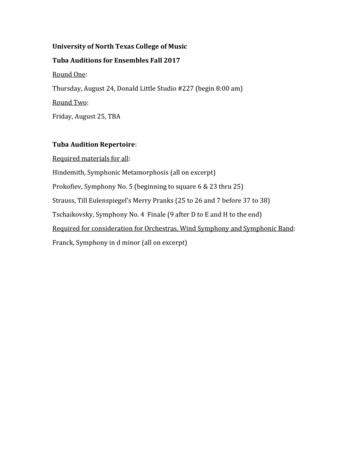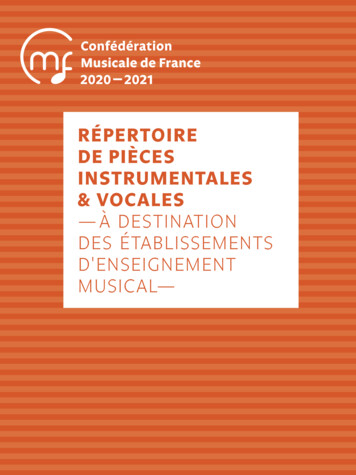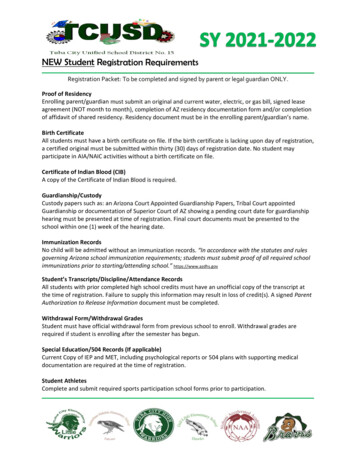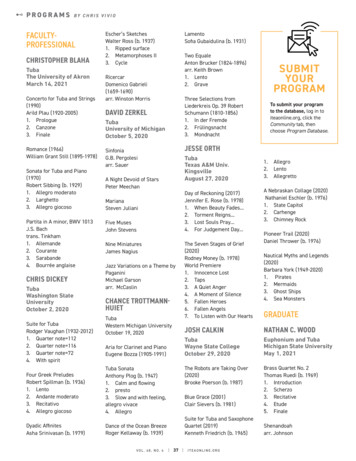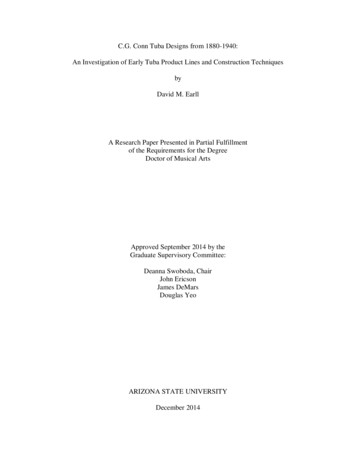
Transcription
C.G. Conn Tuba Designs from 1880-1940:An Investigation of Early Tuba Product Lines and Construction TechniquesbyDavid M. EarllA Research Paper Presented in Partial Fulfillmentof the Requirements for the DegreeDoctor of Musical ArtsApproved September 2014 by theGraduate Supervisory Committee:Deanna Swoboda, ChairJohn EricsonJames DeMarsDouglas YeoARIZONA STATE UNIVERSITYDecember 2014
ABSTRACTThe C.G. Conn instrument manufacturing company is known as one of the mostsuccessful and innovative band instrument manufacturers in the history of the UnitedStates. Many of C.G. Conn's instrument product lines have undergone significant changesthroughout the company's history, especially in the brass family. The C.G. Conn tubaproduct lines are no exception to this company's extraordinary success, and have beensignificantly redesigned since the company began manufacturing these instruments incirca 1880. This research project investigates the tuba product lines that C.G. Connmanufactured between 1880 and 1940. C.G. Conn designed six different tuba productlines during this timeframe, including an unnamed tuba product line with Stölzel valves,the Wonder Valve line, the New American line, the Wonder Model line, the 20-J, and the22-J instrumental product lines. These tuba product lines have been investigated usingextant publications and patent information because the majority of C.G. Conn's internalrecords prior to 1970 have been lost. In addition to investigating each of C.G. Conn'searly tuba product lines, this project also explores the particularly anomalous design inthe top-action valve apparatus of the Conn Wonder Model tuba product line. Thisanomalous design was implemented in the all of C.G. Conn's top-action tuba and tubalike product lines from circa 1890-1940. This author's measurements of periodinstruments and analysis of data taken from these measurements indicates that thisanomalous top-action valve apparatus design utilized interchangeable parts with otherfront-action C.G. Conn tuba product lines.i
ACKNOWLEDGMENTSThe author would like to thank the following individuals and organizations for theircontributions to this project.Committee Members:Dr. Deanna Swoboda – Assistant Professor of Tuba and Euphonium –Arizona State University – Advisor and Committee ChairDr. James DeMars – Professor of Music Theory and Composition –Arizona State UniversityDr. John Ericson – Associate Professor of Horn and Brass Area Coordinator –Arizona State UniversityDouglas Yeo – Professor of Practice: Trombone – Arizona State UniversityNational Music Museum – University of South Dakota – Vermillion, South Dakota:Dr. Margaret Downey Banks – Associate Director, Senior Curator of MusicalInstruments, Professor of Music – University of South Dakota –Advisor of On-Site ResearchSupporting Organizations:2013 Northern Trust/Piper Enrichment AwardU.Discover Summer Scholar Research ProgramAdditional Thanks:Samuel Pilafian – Professor of Tuba and Euphonium – Frost School of Music, Universityof Miami – Former Advisor and Committee Chair of this Research ProjectDr. Kenneth P. Drobnak – Assistant Professor of Music, Director of Bands –Northwestern Oklahoma State Universityii
Dr. Steven Sudduth – Assistant Professor of Music, Director of Bands,Professor of Low Brass – University of the CumberlandsSpecial Thanks:While it would be impossible to thank all of the outstanding individuals who havebeen a part of my academic and professional journey, I want to extend my appreciation toa number of people who have left an irreversible mark on my life for the better. Inparticular, I wish to thank my family for their support of my dreams. Mike and MaryEarll, I couldn’t ask for more loving or supportive parents, and I will always look up toyou both. Josh Earll, you are as supportive as a brother could be, and I always appreciateyour opinions as my sounding board. To Barb and Lyle Earll and to Anne and FrankBreuker; I could not have asked for four more supportive grandparents and lifelong rolemodels.Additionally, I would like to extend a special thanks to my Arizona ‘family,’ whowere there to support me through each step through graduate school. To Kathy Berry andLeonora Stephanoff, you made me feel like family from the first time we met, and I amgrateful to have been found by two such outstanding ‘Arizona grandmothers.’ To myfriends Susan, Michael, and Tyler McCall, I will always be grateful for having you in mylife as well.Lastly, I would like to thank all of my music teachers who are not listed above.Each of you were the inspiration for me to follow my dreams, to work harder than I knewwas possible, and to open a door to a more exciting career than I could have ever hopedfor. Mike Andersen, Rolyn Beaird, Galen Benton, Peter Carlson, Luci Ferrin, LorendaGlade, Kelly Jacobsma, Cindy Kemp, Corkey Koerselman, Dr. Larry Mitchell, Dr. Rolfiii
Olson, Dr. Gary Reeves, and Dr. Stephen Yarbrough: each of you are my heroes and rolemodels. Thank you for planting the love of music in my life and helping me walk on thisjourney to my calling.iv
TABLE OF CONTENTSPageINTRODUCTION .1CHAPTER1THE EARLY C.G. CONN TUBA PRODUCT LINES . 4Section 1: The Success and Advertisement of Early C.G. Conn Tubas . 5Section 2: The First Known C.G. Conn Tuba Product Line . 10Section 3: The C.G. Conn “Wonder Valve” Tuba Product Line . 15Section 4: The C.G. Conn “New American” and“Wonder Model” Tuba Product Lines . 21Section 5: The C.G. Conn 20-J and 22-J Tuba Product Lines . 332INVESTIGATION OF THE C.G. CONN TUBA CONSTRUCTION TECHNIQUESAND DESIGN . 35Section 6: Review of the Anomalous C.G. Conn Tuba Design . 36Section 7: The Anatomy of Concert Tubas . 38Section 8: The Atypical Design of the C.G. Conn Top-Action Tubas . 45Section 9: The Influence to Pursue Comparative Measurements. 51Section 10: The Method of Comparative Measurements . 54Section 11: Outcomes of the Comparative Measurements . 56CONCLUSION. . 58BIBLIOGRAPHY. . 59v
PageAPPENDIXAC.G. CONN TUBA-RELATED PERIODICALS . 64BC.G. CONN TUBA-RELATED PATENTS . 118CDIAGRAMS OF MEASURMENT POINTS ON FRONT-ACTION TUBAS. 132DDIAGRAMS OF MEASUREMENT POINTS ON TOP-ACTION TUBAS . 145EPHOTOGRAPHS OF PROCEDURES AND INSTRUMENTS . 157FMEASUREMENTS AND FIELD RESEARCH DATA . 167GSUPPLEMENTAL IMAGES . 175HPERMISSION LETTERS . 178vi
INTRODUCTIONThe C.G. Conn instrument manufacturing company is recognized as one of themost successful and innovative band instrument manufacturers in the history of theUnited States. The strides this company made in instrument design (particularly in valvetechnology, instrument wrap1, and bore diameter expansion)2 were especially importantto the integration of new concepts in the development of the concert tuba3, which hadbeen first patented only thirty-nine years before C.G. Conn was founded in 1874. 4Unfortunately, much of the historical documentation regarding the C.G. Conn instrumentmanufacturing company’s construction techniques, equipment, and training have beenlost due to factory fires in 1883 and 1910. 5 Beyond the loss of these early records, almostall of C.G. Conn’s historical documents after the factory fire of 1910 were unfortunatelydisposed of during a transition in the company’s corporate headquarters during the1970s.6 Despite the loss of these historical records, it is still possible to investigate thischapter in the development of the modern tuba through other research methods. Theprincipal methods used to investigate this timeframe will include examination of extantperiod (circa 1880-1940) advertisements and periodicals, analysis of patent information,1‘Wrap’ is a term used in brass instrument manufacturing that is used to discuss the curvature of tubing inan instrument.2Jeffrey Paul Hodapp, “The York Tuba : Design Idiosyncrasies that Contribute to its Unique Sound”(DMA diss., University of Madison-Wisconsin, 2002), 26-44.3‘Concert tubas’ are often simply referred to as tubas, and typically played in a seated position. Thisinstrument design will be discussed at length throughout this document, and excludes other tuba-likeinstruments such as sousaphones, helicons, and bombardons.4Margaret Downie Banks, "A Brief History of the Conn Company (1874-present)," National MusicMuseum, http://people.usd.edu/ mbanks/CONTENT.html (accessed February 14, 2012).5Ibid.6Margaret Downie Banks, “The Conn Company Archive,” National Music Museum,http://orgs.usd.edu/nmm/connarch.html (accessed June 20, 2014).1
and measurements taken from period tuba models from the instrument collections at theNational Music Museum of Vermillion, South Dakota.This document investigates the six earliest tuba product lines produced by theC.G. Conn instrument manufacturing company between approximately 1880 and 1940and discusses the design of these instrument product lines in Chapter 1. The first two tubaproduct lines were only offered by C.G. Conn over the course of approximately ten yearswhich is a rather brief period of time when compared to this company’s third design.C.G. Conn’s third tuba design was in production for nearly fifty years. The two tubaproduct lines of this third design, based on two patents granted to Charles Gerard Conn in1889 and 1890, were first made available for purchase circa 1890 and became the basicdesigns for all of C.G. Conn’s concert tuba, euphonium, baritone, tenor horn, and altohorn7 product lines manufactured by the C.G. Conn instrument manufacturing companyuntil 1940. 8 C.G. Conn’s next two tuba product lines were released in roughly 1940, andimplemented new designs which differentiated these instruments significantly from theearlier tuba product lines. 9The two tuba product lines of the third C.G. Conn design, called the “NewAmerican Model” and “New Wonder Model” tubas, 10 were highly endorsed by leadingartists of the time11 and were considered to demonstrate high quality in their7This list of instruments (the euphonium, baritone, tenor horn, and alto horn) will often be referred to as‘tuba-like’ instruments throughout this document due to be construction similarities that these instrumentsexhibit, especially in early C.G. Conn instrument design.8C.G. Conn, Selling Points and Testimonials “Bass.” (Musical Instrument Manufacturers Archive ConnCatalogs 1888-1949, National Music Museum, 1923-1924), 5-18.9C.G. Conn, Conn Band and Orchestra Instruments, (Musical Instrument Manufacturers Archive ConnCatalogs 1888-1949, National Music Museum, September 1940), 36-37.10C.G. Conn, Wonder and American Model Valve Instruments. (Musical Instrument ManufacturersArchive Conn Catalogs 1888-1949, National Music Museum, 1895).11Conn, Selling Points and Testimonials “Bass,” 1 22-36.2
construction. 12 While these tuba product lines showed immense success in the highlycompetitive instrument sales market of the United States during their time ofmanufacture,13 the New Wonder Model tuba and tuba-like product lines were built with ahighly anomalous valve apparatus design when compared to many contemporary andmodern tuba models. This atypical design and the potential reasons for such a design inthe New Wonder Model tubas and tuba-like product lines will be discussed at length inChapter 2, including a new study of the apparent use of interchangeable parts between theNew Wonder Model tuba product lines and the New American Model tuba product lines.12John Joseph Swain, “A Catalog of the E-flat Tubas in the Arne B. Larson Collection at the University ofSouth Dakota.” (PhD diss., Michigan State University, 1985), 221.13Hodapp, 7.3
CHAPTER 1THE EARLY C.G. CONN TUBA PRODUCT LINES4
SECTION 1: THE SUCCESS AND ADVERTISEMENT OF EARLY C.G. CONNTUBASThe C.G. Conn instrument manufacturing company is well known for itsinnovative and competitive role in the early environment of band instrument constructionand sales in the United States. Although this company originally designed and soldcornets after their foundation in 1874, C.G. Conn quickly became one of the mostcompetitive distributors of nearly every band instrument and was endorsed by musicalartists from both the United States and abroad.14 The C.G. Conn tuba product lines wereno exception in this company’s success, and were as heavily endorsed by artists as thecornets and trumpets with which C.G. Conn established its early national prestige. 15The first three tuba product lines that the C.G. Conn instrument manufacturingcompany designed and manufactured were available from approximately 1880 to 1940.Many of these tuba models were a common fixture in many of the preeminent concertbands and orchestras and the choice of many tuba artists throughout the United States.16Additionally, these tuba product lines were able to maintain a considerable amount ofsuccess during this timeframe when many instrument manufacturing companies werevying for a place in the competitive instrument market in the United States. Companiessuch as York & Sons, H.N. White, Holton, and the Grand Rapids Instrument Companywere all simultaneously working to secure their individual successes 17 alongside C.G.Conn in this unpredictable period in instrument manufacturing history, and each of thesepopular manufacturers witnessed other young companies struggle and fail to survive in14Swain, 271.Conn, Selling Points and Testimonials “Bass,” 22-36.16Ibid. 1 22-36.17Hodapp, 4-10.155
such a competitive and quickly evolving market.18 The source of the C.G. Conninstrument manufacturing company’s success in sales during this timeframe is likely aculmination of a multifaceted and well-managed business plan that was adjusted carefullythroughout this company’s development 19 coupled with C.G. Conn’s commitment to thequality of their instrumental products through innovative and adaptive constructiontechniques.20The C.G. Conn instrument manufacturing company was not only innovative inconstruction techniques but was at the forefront of marketing and advertising during thisthese early years of instrument manufacturing and sales in the United States. 21 Like manycompanies of this era, C.G. Conn initially worked as a mail-order business,predominantly distributing full product catalogs that contained brief descriptions of theirinstruments and some reviews from notable artists of the era.22 In addition to these fullproduct catalogs, C.G. Conn began to release a publication titled C.G. Conn’s Truth23 inSeptember of 1890 and kept these periodicals in publication into the 1940s.24 Unlike atypical mail-order catalog, the C.G. Conn’s Truth periodicals were filled with stories,endorsements, images, and anecdotes about C.G. Conn instruments. Many of theseperiodicals included success stories of ensembles comprised entirely, or at least in18Swain 267-274.Swain, 270-272.20Conn, Selling Points and Testimonials “Bass,” 2-4.21Trevor Herbert, "Selling brass instruments: The commercial imaging of brass instruments (1830-1930)and its cultural messages," Music In Art: International Journal for Music Iconography 29, no. 1-2 (March1, 2004): /ehost/pdfviewer/pdfviewer?vid 6&sid 2&hid 122 (accessed August 18, 2014).22Swain, 271.23Sometimes referred to as the C.G. Conn Musical Truth, Conn’s Truth, or Conn’s Musical Truth.24Deborah Check Reeves, “C.G. Conn’s Double-Wall Wonder Clarinets.” National Music leWallClarinets/ConnDblWallClarinetsBanks.html (accessedJuly 12, 2014)196
majority, of C.G. Conn instrument players, humorous stories from these musicians, andsections devoted to endorsements of specific instruments by players and conductors inboth recognized and budding ensembles throughout the United States and evenoccasionally from abroad.25 While the C.G. Conn’s Truth publications were seeminglydesigned to be for the entertainment and enrichment of a musically savvy audience, theperiodical also included pricing and ordering information for the instrumental productsthat were endorsed in each issue. This new form of marketing periodical demonstratedC.G. Conn’s versatility and ingenuity in the competitive marketing environment thatevolved around musical instrument sales and construction in the United States during thelate 1800s. Several examples of the imagery, prose, and endorsements taken from a C.G.Conn’s Truth may be seen in further detail in Appendix A.Beginning in the 1920s, the C.G. Conn instrument manufacturing company alsobegan to publish a series of instrument-specific catalogs and pamphlets for each of theC.G. Conn band instrument product lines, although they had been publishingcornet/trumpet-specific marketing materials as early as the 1890s. These instrumentspecific catalogs were extensive collections of high-fidelity images, constructioninformation, dimensions, accessories, advertisements, and endorsements of theinstrument featured within each publication. The endorsement sections of theseinstrument-specific catalogs were similar in content to the endorsements found in manyof the C.G. Conn Truth periodicals, but were typically much more extensive and allowedfor greater focus on each instrument’s most renowned artists as well as budding artists25C.G. Conn, C.G. Conn’s Truth Vol. 5, No. 7 (Musical Instrument Manufacturers Archive Conn MusicalTruth 1897-1918, National Music Museum, November 1903), 26-27.7
throughout the United States.26 The instrument-specific pamphlets utilized some of theimages and advertisements used in the instrument-specific catalogs, but wereconsiderably limited in length and as such focused on basic product lines and orderinginformation. 27 These instrument-specific marketing materials served as a targetedmarketing tool for the C.G. Conn instrument manufacturing company and allowed for thegeneral catalogs to be less cumbersome. The instrument-specific marketing materialsprovided separate but considerably detailed information to each of their specificinstrumental clientele. An example of a tuba-specific catalog (1923-1924) and severalselections from a euphonium-specific (1921) catalog from this period of advertisementcan be seen in further detail in Appendix A, figures A-4 and A-5.While C.G. Conn’s marketing expertise and diversity in advertisements likelyplayed a major role in this company’s overall success in the competitive musicalinstrument trade of the early 1900s, C.G. Conn was also known for the remarkablequality of their instruments. C.G. Conn’s early tuba product lines were one of manyproduct lines that were standards in the musical instrument industry and were known tohave a very high quality of construction which likely contributed to their success.28 Inparticular, the two tuba product lines that were patented and manufactured by C.G. Connin 1889 and 1890 became the basic designs for all of this company’s concert tuba,26Conn, Selling Points and Testimonials “Bass,” 22-36.C.G. Conn, French Horn, Mellophone, Alto (Musical Instrument Manufacturers Archive Conn Catalogs1888-1949, National Music Museum, ca. 1927), 16.28Hodapp, 6-8.278
euphonium, baritone, and alto horn29 product lines until approximately 1940. 30 Each ofthe separate instrumental product lines that utilized these two early designs was also quitesuccessful in the competitive market of musical instrument sales in the United States, 31 atleast in part due to the high level of quality in construction for which C.G. Conn becameso well known.3229Details of each of these instrumental product lines can be seen in further detail in Appendix A.Conn, C.G. Conn’s Truth Vol. 5, No. 7, 18-27.31Hodapp, 6-8.32Swain, 221 271.309
SECTION 2: THE FIRST KNOWN C.G. CONN TUBA PRODUCT LINEThe first known C.G. Conn tuba product was made available as early as 1879, 33and the design included a modified Stölzel valve for which Charles Gerard Conn receiveda patent on November 1, 1881.34 Stölzel valves are an early variety of piston valvedeveloped originally by Henrich Stölzel as early as 1814. Dr. Sabine Klaus states thefollowing in her writing about the elements of brass instrument construction:The main difference between the Stölzel valve and the [modern] Périnet 35[ ] valves is that the main tubing enters the piston from below. Twodifferent Stölzel valve models can be distinguished. In the "early model,"the piston is guided and the spring is stopped by a horizontal screw, goingthrough the outer casing. In the "later model," the spring is enclosed in abarrel; therefore, no screw is visible at the valve casing. Guidance isprovided by a key fitting in a groove or keyway at the valve casing. 36The Stölzel valve featured in this tuba model’s design would be classified as the latermodel mentioned above. 37 Further details of this modified Stölzel valve patent can befound in Appendix B, in figure B-1.In addition to this tuba model’s unique implementation of modified Stölzelvalves, this model also featured a noteworthy design which causes the instrument’s leadpipe to travel behind the valve apparatus and form a hand grip for its player. The earlyStölzel valve tuba model also featured engraved metal touch-pieces on the valves, ratherthan the inlaid mother-of-pearl touch-pieces which became C.G. Conn’s standard33Tuba pitched in E-flat by C.G. Conn, Serial Number 4037, NMM 5,892, Musical Instrument Collection,National Music Museum, The University of South Dakota, Vermillion, SD, ca. 1880-1881.34Charles G. Conn, Piston-Valve Musical Instrument, US Patent No. 249,012, filed April 2, 1881, andissued November 1,1881.35The Périnet valve will be discussed at length in Section 3.36Sabine Klaus, “Elements of Brass Instrument Construction,” National Music /brassfaq.html (accessed July 14, 2014).37Charles G. Conn, Piston-Valve Musical Instrument, US Patent No. 249,012, filed April 2, 1881, andissued November 1,1881.10
accoutrement for brass instrument product lines starting as early as 1888. 38 This tubamodel was available in the key of E-flat with a top-action39 valve assembly, but it isunlikely this design was also available in the key of B-flat.40 The loss of so many earlyC.G. Conn records due to factory fires in 1883 and 1910 has left the name of this productline a mystery even though it was likely available for between roughly six and tenyears. 41 It is possible that this tuba model was advertised during this timeframe, but anyextant periodicals available from 1879-1888 do not reference this line of tuba model. Itcould be that this tuba product line was available only by request until C.G. Connreleased the company’s next tuba product lines in approximately 1888.This first tuba model with Stölzel valves shares very few design characteristicswith the product lines patented in 1889 and 1890 which were mentioned above, possiblydue to the tightness of wrap that Stölzel valves can cause in tuba design when comparedto Périnet pistons. While an image of this tuba model was not available in any C.G. Connperiodicals, an extraction of an image from Charles Gerard Conn’s United States patentNo. 249,012 can be seen below in figure 2.1. Unfortunately, this patent diagram is notentirely accurate to the final design of this instrument. The lead-pipe construction of thistuba model must have been modified at some time after this patent was submitted. Thistuba model’s final design lengthened the lead-pipe section of the instrument to enter intothe third valve casing, rather than the first valve entry that is shown below. Aside from38Tuba pitched in E-flat by C.G. Conn, Serial Number 4037, NMM 5,892, Musical Instrument Collection,National Music Museum, The University of South Dakota, Vermillion, SD, ca. 1880-1881.39The term ‘action’ refers to the placement of valves on a tuba, which are most typically listed as ‘topaction/right-facing’ and ‘front-action/left-facing.’ This common tuba construction variable will bediscussed at length later in this document.40C.G. Conn, C.G. Conn – Solo and Band Instruments Catalog, (Musical Instrument ManufacturersArchive Conn Catalogs 1888-1949, National Music Museum, 1888).41Banks, “The Conn Company Archive.”11
construction difference in the lead-pipe, the remainder of this basic design is quite similarto the single C.G. Conn Stölzel valve tuba model which is in the musical instrumentcollection of the National Music Museum in Vermillion, South Dakota.42Figure 2.1: 43 The first known C.G. Conn tuba productwith Stölzel valves. Model name unknown, pitched inE-flat, available circa 1880-1888.42Tuba pitched in E-flat by C.G. Conn, Serial Number 4037, NMM 5,892, Musical Instrument Collection,National Music Museum, The University of South Dakota, Vermillion, SD, ca. 1880-1881.43Charles G. Conn, Piston-Valve Musical Instrument, US Patent No. 249,012, filed April 2, 1881, andissued November 1,1881.12
It is tempting to consider that this first C.G. Conn tuba model with Stölzel valvesmay have been imported or designed using European patents due to a popular trend inearly musical instrument manufacturing in the United States. Not only is the design ofthis tuba model so fundamentally dissimilar in design from all of C.G. Conn’s subsequentlow brass product lines, the presence of a traditionally German Stölzel valve on a tubamanufactured in the United States is also considerably anomalous. The practice ofimporting and then signing unmarked instruments from Europe was fairly popular withearly American instrument manufacturers, especially when these manufacturers were inthe first stages of selling new instrument product lines. 44 While this practice was fairlypopular in this timeframe, and certainly would have been a viable option for the staff atthe C.G. Conn instrument manufacturing company, there is enough extant documentationto provide a strong case that this tuba model was indeed designed and manufactured byC.G. Conn. The strongest argument that this tuba model was designed and manufacturedby C.G. Conn is found in Charles Gerard Conn’s patent from 1881 to modify Stölzelvalves, specifically in the context of tuba and valve trombone product lines. 45 Anengraving on the bell of this tuba model in the musical instrument collection of theNational Music Museum which claimed that the instruments were “made by C.G. Conn[of] Elkhart [Indiana]” 46 serves as an additional, if somewhat less credible, sample ofevidence that this instrument was designed and manufactured in the United States,because many of the other musical instrument manufacturers that were importing and44Swain, 271.Charles G. Conn, Piston-Valve Musical Instrument, US Patent No. 249,012, filed April 2, 1881, andissued November 1,1881.46Tuba pitched in E-flat by C.G. Conn, Serial Number 4037, NMM 5,892, Musical Instrument Collection,National Music Museum, The University of South Dakota, Vermillion, SD, ca. 1880-1881.4513
signing unmarked instruments would make similar claims. 47 Particularly with C.G.Conn’s patent information as support of this tuba model’s design, this tuba model wasmost likely designed and constructed by C.G. Conn in the United States rather than beingimported despite this tuba product line’s somewhat anomalous design and the popularityof the this importation trend.47Swain, 271-272.14
SECTION 3: THE C.G. CONN “WONDER VALVE” TUBA PRODUCT LINEThe next C.G. Conn tuba product lines which were regularly advertised and madeavailable for sale from approximately 1888-1890 are also unlike all of the later C.G.Conn tuba, euphonium, baritone, and alto horn product lines. These two new tuba productlines were titled the “New Model Wonder Valve Double Bb Bass” 48 model and the “BellUp Wonder Valve Eb Bass,” model, and featured top-action valve assembly with bottomsprung Périnet piston valves. 49 Périnet piston valves are one of the most common pistonvalves found on modern brass instruments, and are described by Dr. Sabine Klaus in herwritings on brass instrument construction:The Périnet valve is named after François Périnet, the Parisian whoinvented this type of piston valve in 1838 and patented it the followingyear. The valve loops are arranged in such a way that the inlet tubing ispositioned on a different level than the outlet tubing. The piston is held atrest by a spring, which is placed either on top (top-sprung) or below(bottom-sprung) the piston. The Périnet valve is now the standard fortrumpets in most countries (except Germany and Austria), and is oftensimply called the ‘piston valve.’50Both of these tuba models were part of a series of instrument product lines that C.G.Conn marketed as the “Wonder Valve Band Instruments.” Alto horns, tenor horns,baritones, euphoniums, tubas, and helicons were all advertised as Wonder Valveinstruments in this 1888 C.G. Conn catalog,51 and it is likely that each of theseinstrumental product lines included a design from the Périnet valve modification patentwhich was issued to Charles Gerard Conn on June 15, 1886. Initially this patent seems toindicate this valve modification is intended to be implemented in cornets, but Conn states48Tubas in this timeframe were often referred to as basses, brass basses, or even blow basses.Co
U.Discover Summer Scholar Research Program Additional Thanks: Samuel Pilafian - Professor of Tuba and Euphonium - Frost School of Music, University . University of the Cumberlands . "A Catalog of the E-flat Tubas in the Arne B. Larson Collection at the University of South Dakota." (PhD diss., Michigan State University, 1985), 221 .
